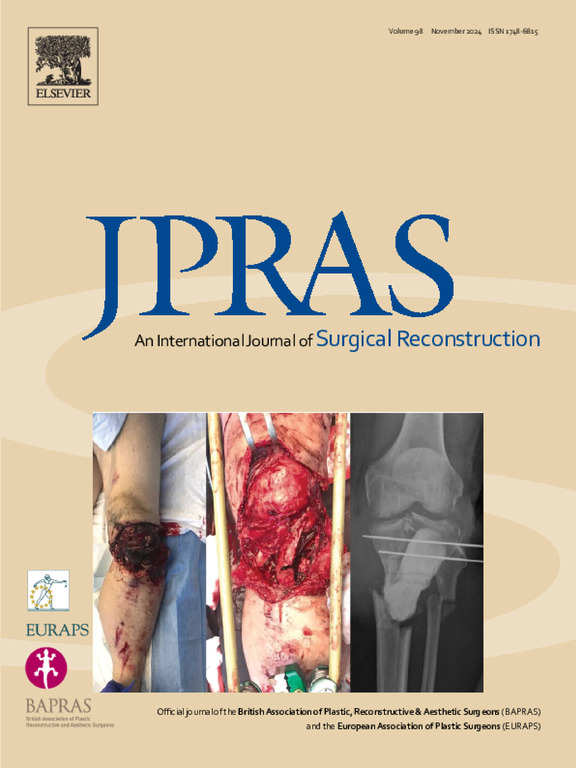利用光声学断层扫描对腹部疤痕患者应用的下腹深动脉穿孔皮瓣中线交叉动脉变异进行无创观察
IF 2
3区 医学
Q2 SURGERY
Journal of Plastic Reconstructive and Aesthetic Surgery
Pub Date : 2024-09-07
DOI:10.1016/j.bjps.2024.09.010
引用次数: 0
摘要
背景据报道,横向腹部皮瓣中穿越中线的皮下动脉网络非常重要。光声断层扫描可用于无创观察皮下血管网络。我们将这项新技术应用于乳房重建患者的术前检查,以检测中线交叉动脉的个体差异。每次扫描 12 × 8 厘米区域的时间约为 8 分钟。将光声断层扫描确定的暂定动脉评估的准确性与术中吲哚菁绿血管造影检测的动脉相位进行了比较。结果5例患者中,光声断层扫描的暂定动脉预测与术中血管造影的动脉相位评估的平均匹配率为79.8%。每条中线交叉动脉都有个体差异。光声断层组(PAT-1 至 5)显示每个皮瓣有 1.8 条穿孔动脉,皮瓣提升时间为 163 分钟,灌注面积为 93%,与对照组(N = 5)无明显差异。一名 63 岁的妇女(PAT-6)腹部有疤痕,包括腹部中线切口,但保留了一条中线交叉动脉。结论照片声学断层扫描可无创地观察皮下中线交叉动脉网络。了解个体血管变化有助于腹部皮瓣的术前规划和手术指征,尤其是对术后有疤痕的患者。本文章由计算机程序翻译,如有差异,请以英文原文为准。
Noninvasive visualization of the midline-crossing arterial variation in the deep inferior epigastric artery perforator flap using photoacoustic tomography for application in patients with abdominal scars
Background
The importance of the subcutaneous arterial network crossing the midline in transverse abdominal flaps has been reported. Photoacoustic tomography can be used to noninvasively visualize subcutaneous vascular networks. We applied this novel technology preoperatively in patients undergoing breast reconstruction to detect individual variations in the midline-crossing arteries.
Methods
Six patients scheduled to undergo breast reconstruction using free deep inferior epigastric artery perforator flaps were examined. Each scan of the 12 × 8-cm region took approximately 8 min. The accuracy of the tentative artery evaluation defined by photoacoustic tomography was compared with the arterial phase detected by intraoperative indocyanine green angiography. The number of perforator vessels used for the flap, surgical time for flap elevation, and perfusion area ratio were compared with those of the control group.
Results
The average match rate between tentative artery prediction by photoacoustic tomography and arterial-phase assessment by intraoperative angiography in five patients was 79.8%. Each midline-crossing artery showed individual variations. The photoacoustic tomography group (PAT-1 to 5) showed 1.8 perforators per flap, 163 min for flap elevation, and 93% perfusion area, with no significant differences from the control group (N = 5). A 63-year-old woman (PAT-6) with abdominal scars, including a midline abdominal incision, showed a preserved midline-crossing artery. The planned single perforator deep inferior epigastric perforator flap was successfully applied to the contralateral perfusion area.
Conclusions
Photoacoustic tomography noninvasively visualizes the subcutaneous midline-crossing arterial networks. Understanding individual vascular variations can support preoperative planning and surgical indication of abdominal flaps, especially in patients with postsurgical scars.
求助全文
通过发布文献求助,成功后即可免费获取论文全文。
去求助
来源期刊
CiteScore
3.10
自引率
11.10%
发文量
578
审稿时长
3.5 months
期刊介绍:
JPRAS An International Journal of Surgical Reconstruction is one of the world''s leading international journals, covering all the reconstructive and aesthetic aspects of plastic surgery.
The journal presents the latest surgical procedures with audit and outcome studies of new and established techniques in plastic surgery including: cleft lip and palate and other heads and neck surgery, hand surgery, lower limb trauma, burns, skin cancer, breast surgery and aesthetic surgery.

 求助内容:
求助内容: 应助结果提醒方式:
应助结果提醒方式:


